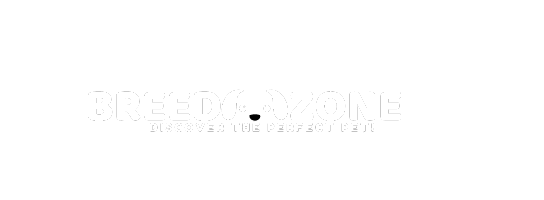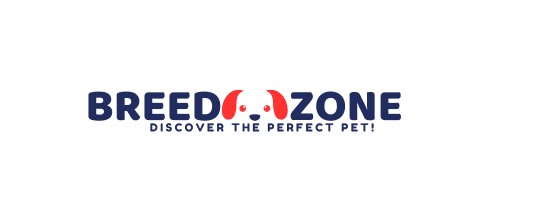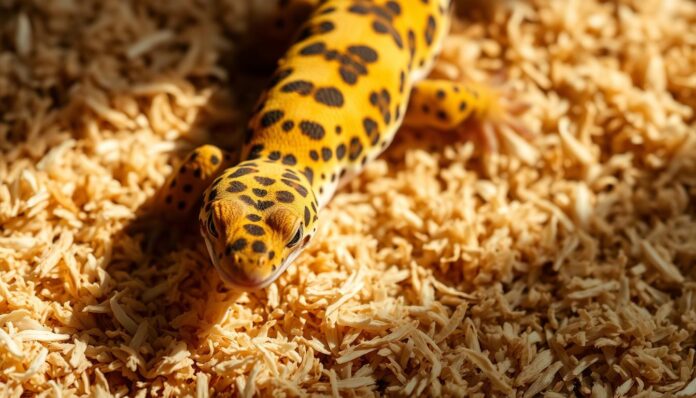More than 90% of reptile impaction cases come from eating the wrong substrates. Choosing the right substrate is key for leopard gecko care. Coconut fiber, or coco coir, is a topic of debate in the reptile world. It’s marketed as versatile but poses challenges for these desert animals.
Experts say coconut fiber’s moisture retention is a problem for leopard geckos. This article looks into its safety and compares it to dry substrates. Even experienced keepers advise caution. The right substrate is not just about looks. It affects health, digestion, and survival.
Leopard Gecko Habitat Requirements
Leopard geckos do best in environments that feel like their desert homes. They come from dry areas like Afghanistan, Pakistan, and India. These places have rocky, sandy grounds with compact soil. It’s important to create a similar setup for them in captivity to keep them healthy and happy.
Natural Environment of Leopard Geckos
In the wild, leopard geckos dig into warm, dry soil. They also hide under rocks. Their bodies are made to live in low humidity and to dig without getting stuck. These natural habits help us know how to care for them in captivity.
Substrate Requirements for Captive Leopard Geckos
Choosing the right best substrate for leopard geckos is key. Stay away from cedar or pine chips because they’re toxic. Instead, use things like coconut fiber. It keeps moisture and lets them dig naturally. But, make sure to clean it often to stop mold.
Importance of Proper Substrate Selection
Choosing the wrong substrate can harm them. For instance:
- Too much humidity can cause breathing problems
- Sharp or rough materials can hurt their skin
- Stuff they can’t digest can block their intestines
| Substrate Type | Pros | Cons |
|---|---|---|
| Coconut Fiber | Keeps moisture, lets them dig | Needs cleaning often |
| Cedar/Pine | Smells good, looks nice | Has toxic fumes |
| Calcium Sand | Safe to eat | Doesn’t hold moisture well |
Choosing the right substrate helps them stay warm and reduces stress. It’s important to do research and keep an eye on their habitat to meet their needs.
What Is Coconut Fiber Substrate?
Coconut fiber substrate is made from coconut husks. These husks are ground and washed to create a natural product. It’s sold in loose bags or compressed bricks. This material is great for reptiles because it holds moisture and breaks down easily.
Coconut fiber substrate comes in three forms. Each has a different texture and use:
- Loose: Fluffy and lightweight for mixing with other substrates.
- Compressed bricks: Expands when hydrated, ideal for humid microhabitats.
- Pre-mixed blends: Combined with calcium sand or bark for specific enclosure needs.
While it’s good for some reptiles, coconut fiber is not safe for leopard geckos. It can be dusty and cause breathing problems. Also, it can get too wet and grow bacteria.
Brands like Eco Earth and Plantation Soil say not to use it alone for leopard geckos. Vets warn that geckos can get intestinal blockages if they burrow in damp coconut fiber.

Some say it’s good because it doesn’t mold like peat moss. But, reptile care guides say it’s risky. It’s okay for some reptiles, but not for leopard geckos.
Is Coconut Fiber Good for Leopard Geckos: A Detailed Analysis
Looking into benefits of coconut fiber for leopard geckos, it’s all about the setup. It has its perks but needs careful handling to keep it safe for your geckos.
- Creates natural burrowing opportunities for stress relief
- Biodegradable and compostable material
- Cost-effective option for moist hide setups
- Available in compressed bricks for easy expansion
Potential Concerns and Risks
- Risk of impaction if ingested (more common with unhealthy geckos)
- Retains moisture too well for arid-dwelling species
- Dust particles may irritate respiratory systems
- Requires careful monitoring to prevent humidity levels exceeding 40%
Expert Opinions on Coconut Fiber Usage
| Expert Type | Recommendation | Conditions |
|---|---|---|
| Reptile Veterinarians | Use only in controlled moist hides | Combined with paper towels for safety |
| Breeders | Preferred for breeding setups | Restricted to lay boxes only |
| Herpetologists | Caution advised | Not recommended as primary substrate |
Eco Earth® Coconut Fiber Substrate is a good choice if used right. Mixing it with Zoo Med’s HydroBalls® helps with drainage but needs constant humidity checks. It’s key to not use it everywhere and keep basking spots dry. Always keep an eye on coconut fiber safety for leopard geckos by limiting it to damp areas.
Moisture Retention Properties of Coconut Fiber
Coconut fiber is great for keeping moisture, but it needs careful use for leopard geckos. It can hold up to eight times its weight in water. This makes it perfect for humid hides, which help with shedding. But, it’s important to manage it well in dry desert-style enclosures.
Humidity Management in Leopard Gecko Enclosures
Leopard geckos do best in 30-40% humidity. They also need a humid hide at 60-70% humidity. To keep things right:
- Check humidity with a hygrometer every day
- Blend coconut fiber with calcium sand or aspen shavings for the right moisture
- Use only 1-2″ deep coconut fiber in the hide area

Preventing Respiratory Issues
Too much humidity from coconut fiber can cause breathing problems. Look out for signs like hard breathing, wheezing, or nasal discharge. To avoid this:
- Make sure there’s good ventilation with screen tops
- Don’t let the coconut fiber get too wet outside the hide
- Change out wet coconut fiber every week to stop mold
Regular checks help keep things safe. Use coconut fiber for moisture in hides. But, use dry substrates in the main area.
Preventing Impaction Risks with Coconut Fiber
Impaction happens when a leopard gecko swallows substrate, like coconut fiber. This is a big problem. Even though coconut fiber is a favorite among leopard gecko substrate options, it’s important to be careful. Using the right products and following safety steps can help avoid these risks.
- Use shallow coconut fiber layers (1-2 inches) to limit digging access.
- Feed geckos in a separate dish to avoid substrate contact during meals.
- Monitor calcium intake—deficiencies may lead to substrate eating (pica).
- Keep substrate dry to prevent mold growth, which exacerbates health risks.
Compared to sand, coconut fiber might be safer if a little is eaten. But eating too much is dangerous. Clean the substrate often and check your gecko’s health regularly. Look for signs like being very tired or having a big belly.
If you think your gecko has impaction, see a reptile vet right away. Keeping your gecko hydrated and at the right temperature helps with digestion. Remember, taking good care of your gecko is more important than just the substrate you use. Make sure to balance their environment with their health.

How to Properly Use Coconut Fiber in Leopard Gecko Terrariums
Using coconut fiber right is key for a good leopard gecko home. Choose fine-grade products like Eco Earth or Plantation Soil. Soak the compressed bricks until they expand, then squeeze out extra water. Make sure it’s damp but not wet.
For safety, sterilize the damp coconut fiber by microwaving it for 2-3 minutes. This kills harmful germs.
Installation Best Practices
- Create a moisture gradient by placing damp coconut fiber in one corner paired with dry sand in others
- Layer substrate 1-2 inches deep to avoid humidity buildup
- Combine with calcium sand in a 50/50 ratio to reduce impaction risks
Maintenance Schedule
| Task | Frequency |
|---|---|
| Spot cleaning | Daily |
| Mold inspection | Every 3 days |
| Full substrate replacement | Every 3-4 months |
Check humidity levels weekly with a hygrometer. Keep it between 30-40% by adjusting the coconut fiber’s moisture. Mix substrates carefully to avoid sudden humidity changes.

Always keep your gecko’s home safe. Use coconut fiber carefully in humidity hides to help with shedding.
You May Like:- Leopard Geckos: Surprising Facts on Their Water Needs
Alternative Substrate Options for Leopard Geckos
Choosing the right substrate for leopard geckos is key. It balances safety and looks. There are many options, each with its own pros and cons.
Loose substrates like Arid ABG mix are popular. They mix sand and soil to look like desert habitats. Topsoil with fine quartz sand lets geckos burrow but watch out for accidental eating.
Excavator clay helps with humidity but can be harmful if eaten. Play sand, sifted to remove small bits, is safe when mixed with solid substrates.
- Reptile carpet or shelf liners: Safe and easy to clean, but can catch claws or hold dirt. Keeping them clean is important to avoid germs.
- Paper towels or newspaper: Cheap and clean, but not as pretty. Good for temporary setups.
- Ceramic tiles or slate: Last long and easy to clean. But, they’re smooth and can cause problems if eaten.
Stones or pebbles add a natural look but can hurt if they’re the wrong size. Always pick substrates that fit your gecko’s lifestyle and needs. Mixing solid and loose substrates is a good way to keep things safe and interesting. Reading reviews and talking to vets helps make sure you’re making the best choice for your gecko.

Mixing Coconut Fiber with Other Substrates: Benefits and Methods
Using coconut fiber with other materials can make a better leopard gecko enclosure substrate. It keeps moisture levels right by mixing it with drier stuff like play sand. For instance, a mix of 20% coconut fiber, 40% topsoil, and 40% sand helps keep humidity in check. It also lets geckos dig and burrow naturally.
Compatible Substrate Combinations
- Coconut coir + sand: This mix adds texture without too much moisture. Try 30% coconut fiber with 70% calcium sand for dry areas.
- Coir + excavator clay: A 40%-40%-20% mix (topsoil/sand/clay) supports humidity levels. It also lowers the risk of impaction.
Creating Microhabitats within the Enclosure
Divide the enclosure into different areas with layered substrates. Use coconut fiber in damp spots for shedding. Pair it with dry sand in active zones. This lets geckos control their environment.
- Start with 1″ of play sand at the bottom.
- Add coconut fiber in humid hides, 1-2″ deep.
- Use silicone barriers to keep substrates from mixing.
Mixed substrates solve is coconut fiber good for leopard geckos worries. They balance coconut fiber’s benefits with safety. Keep an eye on moisture to avoid mold and keep the habitat healthy.
Cost Comparison: Coconut Fiber vs. Other Substrates
When it comes to leopard gecko care, choosing the right substrate is key. Coconut fiber is a cost-effective option compared to others. The initial cost of different substrates varies a lot:
- Coconut fiber: $10–$20 per use
- Sand: $5–$15
- Bio-active mixes: $30–$50
- Recycled paper or hemp: $5–$25
Coconut fiber is durable, which is a big plus for leopard geckos. But, how often you need to clean it can affect your costs. The more you clean, the more you spend over the years:
Initial Investment
Coconut fiber starts at a moderate price. Cheaper options like newspaper are cheap but don’t last long. On the other hand, premium substrates like bio-active mixes cost more upfront. It’s important to consider both the cost and the benefits of each option.
Long-Term Maintenance Costs
Yearly costs can go up if you need to replace the substrate often. Coconut fiber holds moisture, so it might need to be changed every month in humid setups. This adds to your yearly expenses. Options like sand or tile, which need less frequent changes, can save you money in the long run. Remember, vet bills and equipment costs can also impact your budget.
Leopard gecko care tips suggest finding a balance between cost and health benefits. Coconut fiber is a good choice because it’s not too expensive and helps keep the geckos’ environment right. But, how much you save depends on how well you take care of their enclosure and the substrate.
Common Mistakes to Avoid When Using Coconut Fiber
Effective leopard gecko care tips include knowing how to use coconut fiber safely. Many owners make mistakes that can harm their geckos. Here are some common errors to avoid:

- Over-saturating the substrate: Soaking coconut fiber can trap moisture. Always dry it well after setting it up to avoid breathing problems.
- Ignoring humidity checks: Leopard geckos prefer dry environments. Use a hygrometer to keep humidity below 40%.
- Using as sole substrate: Mix coconut fiber with other substrates like reptile carpet in main areas. Use coconut fiber only in moist hides.
- Neglecting maintenance: Change coconut fiber every 3-4 months. Clean it daily to remove waste and stop mold.
- Ignoring juvenile needs: Young geckos are more at risk of impaction. Use paper towel or tile until they grow up.
- Forgetting environmental balance: Make sure your geckos have enough water and UVB light. Always have fresh water bowls available.
Keeping coconut fiber safe for your geckos requires careful attention. Follow these leopard gecko care tips to avoid common mistakes. Regular checks help ensure coconut fiber is safe and beneficial for your geckos.
Conclusion: Making the Right Substrate Choice for Your Leopard Gecko
Choosing the right substrate for leopard geckos is key. It must be safe, healthy, and fit their habitat needs. Coconut fiber is good for moisture and digging, but it’s not for everyone.
Juveniles and geckos with breathing issues might do better with smooth calcium sand or paper towels. Think about the humidity in their enclosure, how often you’ll clean, and their behavior.
Coconut fiber can be great in a humidity hide if used right. But, it must stay dry to avoid mold and dust. Watching it closely is important to keep your gecko healthy.
For most, mixing coconut fiber with reptile carpet or products like Josh’s Frogs Desert BioBedding is safer. You can also make a mix of play sand, topsoil, and excavator clay for a cheaper option.
The best substrate for leopard geckos depends on their needs. Look for ones that are low risk and support their natural behaviors. If you’re new, start with safe options and ask a vet for advice. Changing substrates based on your gecko’s needs is key to their happiness and health.
FAQ
Is coconut fiber good for leopard geckos?
Coconut fiber is a good choice for leopard geckos. It looks natural and breaks down easily. But, it holds moisture, so you need to watch humidity levels.
What are the benefits of coconut fiber for leopard geckos?
Coconut fiber is great for leopard geckos. It helps them dig burrows and fights mold. It’s also cheap and good for the environment.
How does coconut fiber compare to other leopard gecko substrate options?
Coconut fiber is more natural and holds moisture well. But, it’s not perfect for leopard geckos because of the humidity. It’s better mixed with other substrates.
What are the moisture retention properties of coconut fiber?
Coconut fiber can soak up a lot of water. It can hold up to eight times its weight in water. This can make the environment too humid for leopard geckos.
How can I manage humidity levels when using coconut fiber?
To control humidity, use hygrometers and improve air flow. Mix coconut fiber with drier substrates. Keep the substrate layer shallow.
What should I do to prevent impaction risks with coconut fiber?
To avoid impaction, feed your gecko properly and use shallow dishes. Watch their health closely. Make sure they get enough calcium to stop them from eating the substrate.
How should I properly prepare coconut fiber for use in a leopard gecko terrarium?
First, soak and hydrate the coconut fiber. Sterilize it before adding it to the terrarium. Make sure it’s not too wet.
What alternative substrate options are available for leopard geckos?
You can use mixes of topsoil and sand, ceramic tile, or reptile carpet. Each has its own benefits and drawbacks for leopard geckos.
Can coconut fiber be mixed with other substrates?
Yes, mixing coconut fiber with drier substrates is a good idea. This helps keep humidity right and lets geckos behave naturally.
What are the common mistakes to avoid when using coconut fiber?
Don’t use wet coconut fiber and always check humidity. Don’t use it alone in the enclosure. Clean it right to avoid mold. Use the right amount and mix it with drier substrates.


